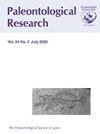日本中部奥马组更新世浅水鲸落群落
IF 0.6
4区 地球科学
Q3 PALEONTOLOGY
引用次数: 0
摘要
摘要我们报道了日本中部金泽市西川沿岸下更新世浅海沉积物Omma组的一块鲸骨,与许多软体动物化石有关。通常在Omma组中发现的大多数软体动物物种都显示出关节缺失和/或外壳受损,表明其存在半本地或异地模式。然而,该组合包含化学合成的双壳类,如萤光纲、比目鱼目和百里香目双壳纲,这些在Omma组中很少见。类软体动物和比目鱼目软体动物表现出较高的铰接率,还有一些捕食性和清除性腹足类,如naticids、nassarids和borsonids,它们保存完好的外壳表明它们是本地发生的。此外,大多数双壳纲软体动物的umbo向上位置与最近物种的生活位置相似。最近的萤光虫、比目鱼目和大多数百里香双壳类的鳃中都有化学共生细菌,是化学合成群落中众所周知的成员。这些证据表明,该群落是一个古老的鲸类群落,主要由双壳类和其他与鲸骨有关的本地软体动物组成。这种最浅的鲸类化石群落与深水案例的不同之处在于,海底双壳类(如软体动物)占主导地位,以及缺乏表动物群和半海底化学合成双壳类,如深海双壳类和囊泡菌类。这个群落支持了之前的一个建议,即鲸鱼群落特征物种的差异取决于水深。本文章由计算机程序翻译,如有差异,请以英文原文为准。
Pleistocene Shallow-Water Whale-Fall Community from the Omma Formation in Central Japan
Abstract. We report a single whale bone associated with many molluscan fossils from the Omma Formation, Lower Pleistocene shallow marine deposits, along the Sai-gawa River, Kanazawa City, in central Japan. Most molluscan species which are commonly found in the Omma Formation show disarticulated and/or damaged shells, indicating semi-autochthonous or allochthonous modes of occurrence. However, the assemblage contained chemosynthetic bivalves, such as lucinid, solemyid and thyasirid bivalves, which are rare in the Omma Formation. The lucinids and solemyids show a high articulation ratio, along with some predatory and scavenging gastropods, such as naticids, nassariids and borsoniids whose well-preserved shells indicate an autochthonous mode of occurrence. In addition, most of the lucinid bivalves show an umbo-upward position similar to the life position of Recent species. Recent lucinid, solemyid and most thyasirid bivalves harbor chemosymbiotic bacteria in their gills and are well known members of the chemosynthetic community. These lines of evidence indicate that the community, mainly comprising lucinid bivalves and other autochthonous molluscan species associated with the whale bone, is an ancient whale-fall community. This shallowest fossil whale-fall community differs from deep-water cases in the dominance of infaunal bivalves, such as lucinids, and in the lack of epifaunal and semi-infaunal chemosynthetic bivalves, such as bathymodiolins and vesicomyids. This community supports a previous suggestion that the difference in characteristic species of the whale-fall communities depends on the water depth.
求助全文
通过发布文献求助,成功后即可免费获取论文全文。
去求助
来源期刊

Paleontological Research
PALEONTOLOGY-
CiteScore
1.60
自引率
0.00%
发文量
47
审稿时长
>12 weeks
期刊介绍:
Paleonotological Research (PR) is a quarterly, peer-reviewed international journal, which focuses on original contributions primarily in the area of paleontology but also covering a wide range of allied sciences. It has been published since 1997 as a successor to the former journal Transactions and Proceedings of the Palaeontological Society of Japan. The emphasis of contributions will include global and local perspectives, and contents can cover all ages (Precambrian to the Quaternary, including the present time).
 求助内容:
求助内容: 应助结果提醒方式:
应助结果提醒方式:


